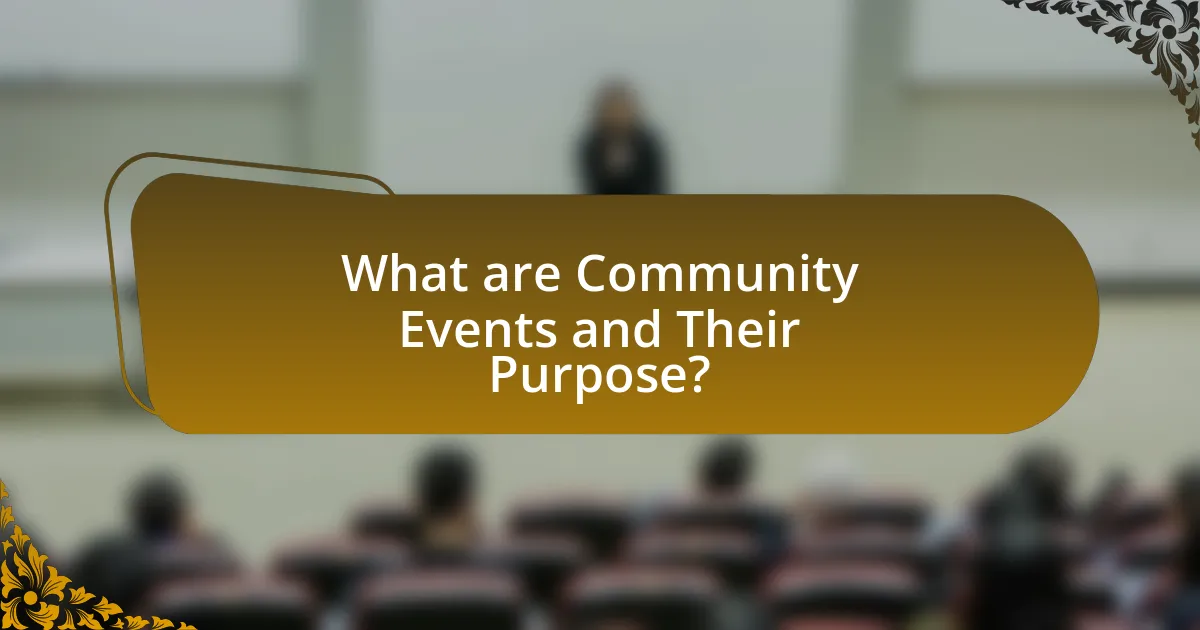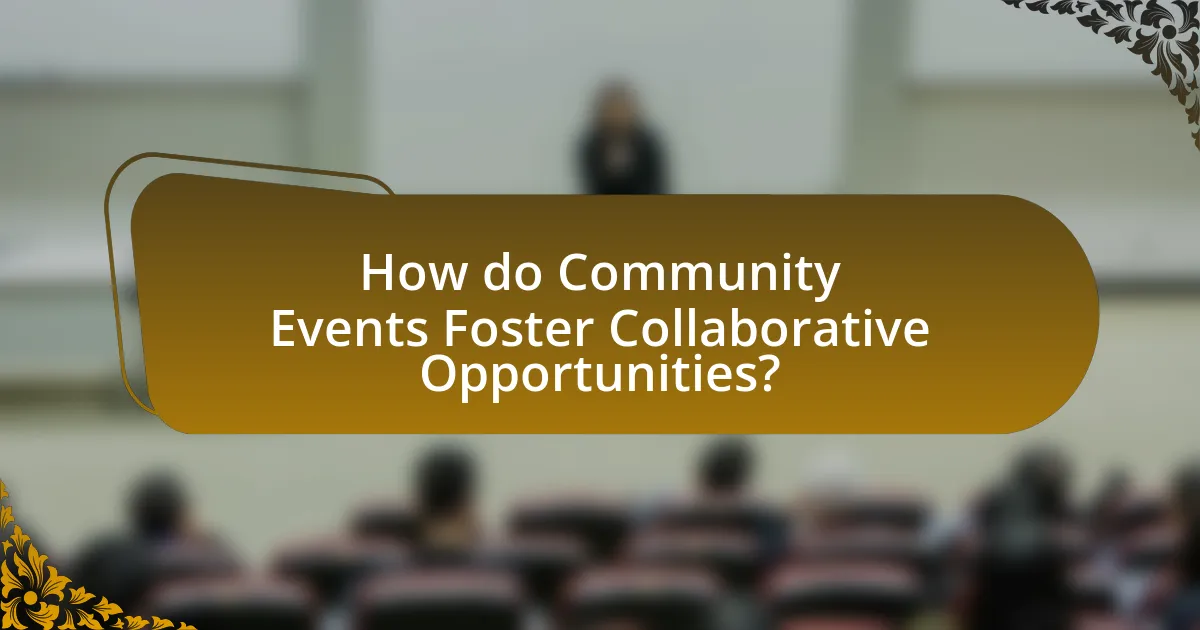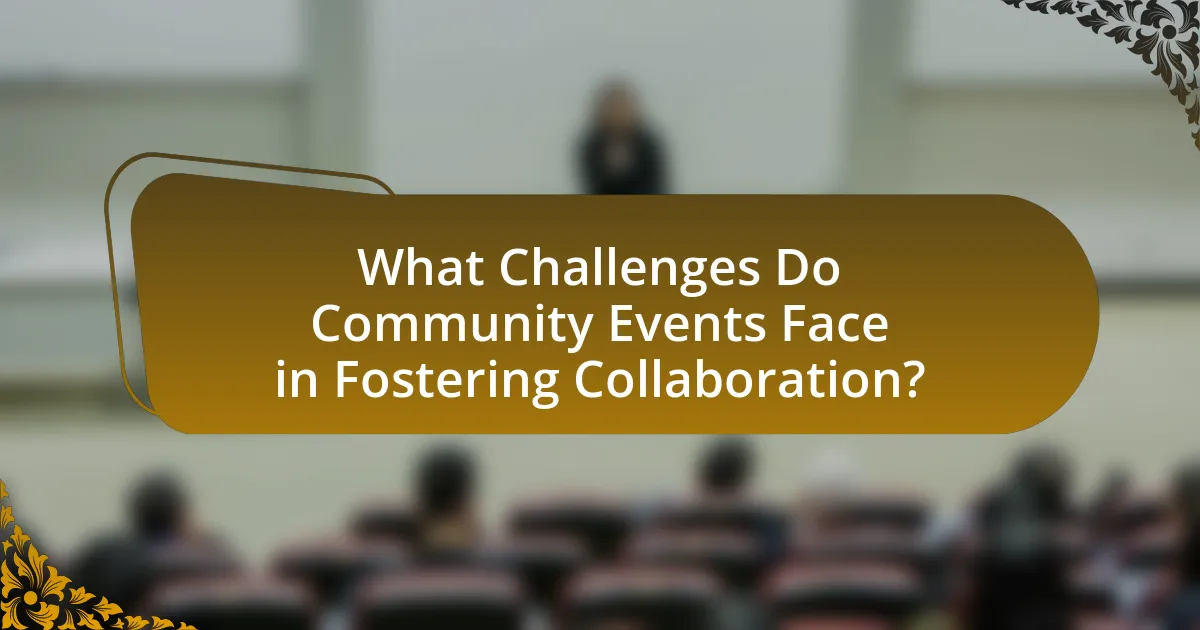Community events are organized gatherings that aim to enhance social interaction, cultural exchange, and community building among local residents. These events play a crucial role in fostering collaboration by providing platforms for networking, resource sharing, and collective problem-solving, which ultimately contribute to increased civic engagement and social cohesion. The article explores various types of community events, their effectiveness in addressing the needs of diverse populations, and the challenges faced in promoting collaboration. It also highlights best practices for organizing successful events that facilitate teamwork and partnership, emphasizing the importance of feedback and innovative approaches in adapting to changing community needs.

What are Community Events and Their Purpose?
Community events are organized gatherings that bring together individuals from a specific locality to engage in activities that promote social interaction, cultural exchange, and community building. The primary purpose of these events is to foster a sense of belonging and collaboration among residents, enhancing social ties and encouraging civic participation. Research indicates that community events can lead to increased social capital, as they provide opportunities for networking, sharing resources, and collaborating on local initiatives, ultimately contributing to the overall well-being and resilience of the community.
How do community events contribute to local engagement?
Community events significantly enhance local engagement by providing platforms for interaction and collaboration among residents. These events foster a sense of belonging and community identity, as they encourage participation from diverse groups, leading to increased social cohesion. Research indicates that communities with active event participation experience higher levels of civic involvement, as evidenced by a study from the National Endowment for the Arts, which found that individuals who attend community events are more likely to volunteer and engage in local governance. Thus, community events serve as vital catalysts for building relationships and promoting active citizenship within local populations.
What types of community events are most effective in fostering collaboration?
Workshops and collaborative projects are the most effective types of community events for fostering collaboration. These events encourage active participation, skill sharing, and collective problem-solving among community members. Research indicates that workshops, which often involve hands-on activities and group discussions, enhance interpersonal connections and build trust, essential components for collaboration. Additionally, collaborative projects that require teamwork to achieve common goals have been shown to increase engagement and strengthen community ties, as evidenced by studies highlighting improved outcomes in community-driven initiatives.
How do community events address the needs of diverse populations?
Community events address the needs of diverse populations by providing inclusive platforms for engagement and interaction. These events often feature activities that cater to various cultural backgrounds, interests, and age groups, ensuring representation and participation from all community members. For instance, festivals celebrating different cultural heritages, workshops in multiple languages, and activities designed for individuals with disabilities exemplify how community events can meet diverse needs. Research indicates that such inclusive events foster social cohesion and enhance community well-being, as they allow individuals from different backgrounds to connect, share experiences, and build relationships, ultimately contributing to a more harmonious society.
Why are collaborative opportunities important in communities?
Collaborative opportunities are important in communities because they enhance social cohesion and collective problem-solving. When individuals come together to collaborate, they share diverse perspectives and resources, leading to innovative solutions for local challenges. Research indicates that communities with strong collaborative networks experience increased civic engagement and improved quality of life. For instance, a study by the National Civic League found that communities with active collaboration initiatives reported higher levels of trust among residents and greater participation in local governance. This demonstrates that collaborative opportunities not only strengthen community ties but also empower residents to address issues collectively, fostering a more resilient and engaged community.
What role do collaborative opportunities play in community development?
Collaborative opportunities are essential in community development as they foster engagement, resource sharing, and collective problem-solving among community members. These opportunities enable diverse stakeholders, including residents, local organizations, and businesses, to work together towards common goals, enhancing social cohesion and trust. Research indicates that communities with strong collaborative networks experience improved outcomes in areas such as economic development, public health, and education, as evidenced by the 2018 study published in the Journal of Community Development, which found that collaborative initiatives led to a 30% increase in community project success rates.
How can collaboration enhance problem-solving within communities?
Collaboration enhances problem-solving within communities by pooling diverse perspectives and resources, leading to more innovative solutions. When individuals from various backgrounds come together, they share unique insights and experiences that can identify root causes of issues more effectively. For instance, a study by the National Civic League found that communities that engage in collaborative problem-solving initiatives report a 30% increase in successful outcomes compared to those that do not. This collective approach not only fosters creativity but also builds trust and strengthens relationships among community members, which are essential for sustained engagement and effective action.

How do Community Events Foster Collaborative Opportunities?
Community events foster collaborative opportunities by bringing together diverse individuals and organizations to engage in shared activities and discussions. These gatherings create a platform for networking, idea exchange, and partnership formation, which can lead to collaborative projects and initiatives. For instance, studies show that community events can increase social capital, as participants build relationships that enhance trust and cooperation. According to research published in the Journal of Community Engagement and Scholarship, community events significantly improve local collaboration by facilitating interactions among stakeholders, thereby promoting joint efforts in addressing community issues.
What strategies can be employed during community events to promote collaboration?
To promote collaboration during community events, organizers can implement strategies such as interactive workshops, team-building activities, and open forums for discussion. Interactive workshops encourage participants to engage in hands-on learning, fostering teamwork and shared problem-solving. Team-building activities, such as group challenges or collaborative projects, create opportunities for individuals to work together towards common goals, enhancing relationships and trust. Open forums for discussion allow community members to voice their ideas and concerns, facilitating dialogue and collective decision-making. Research indicates that events incorporating these strategies lead to increased participant satisfaction and stronger community ties, as evidenced by studies showing that collaborative activities significantly enhance social cohesion and collective efficacy within communities.
How can event organizers facilitate networking among participants?
Event organizers can facilitate networking among participants by creating structured opportunities for interaction, such as breakout sessions, workshops, and networking lounges. These formats encourage attendees to engage with one another in smaller, more focused groups, enhancing the likelihood of meaningful connections. Research indicates that events with dedicated networking time can increase participant satisfaction and lead to higher engagement levels, as seen in studies conducted by the Event Marketing Institute, which found that 84% of attendees value networking opportunities at events. Additionally, utilizing technology, such as event apps that allow participants to connect before and during the event, further supports networking efforts by enabling attendees to schedule meetings and share contact information easily.
What activities can encourage teamwork and partnership during events?
Team-building activities can significantly encourage teamwork and partnership during events. These activities, such as collaborative problem-solving challenges, group workshops, and team sports, foster communication and trust among participants. For instance, studies show that engaging in team-building exercises can improve group dynamics and enhance cooperation, leading to more effective collaboration. According to a report by the Association for Psychological Science, structured team-building activities can increase team performance by up to 25%. This evidence supports the effectiveness of such activities in promoting teamwork and partnership during community events.
What are the outcomes of successful collaboration at community events?
Successful collaboration at community events leads to enhanced social cohesion and increased community engagement. When individuals and organizations work together, they foster relationships that strengthen community ties, as evidenced by studies showing that collaborative events can increase participation rates by up to 50%. Additionally, successful collaboration often results in shared resources and knowledge, which can improve the quality and impact of community initiatives. For instance, a report by the National Civic League highlights that communities with strong collaborative networks are more likely to achieve sustainable development goals and address local challenges effectively.
How do collaborative opportunities lead to sustainable community projects?
Collaborative opportunities lead to sustainable community projects by pooling resources, knowledge, and skills from diverse stakeholders, which enhances project viability and longevity. When community members, organizations, and local governments work together, they can identify shared goals and leverage each other’s strengths, resulting in more effective solutions. For instance, a study by the National Community Development Association found that communities engaging in collaborative planning processes saw a 30% increase in project success rates compared to those working in isolation. This collective approach not only fosters innovation but also builds trust and social capital, essential for maintaining long-term community engagement and support for projects.
What impact do collaborative events have on community relationships?
Collaborative events significantly enhance community relationships by fostering trust, communication, and a sense of belonging among participants. These events create opportunities for individuals from diverse backgrounds to engage with one another, share ideas, and work towards common goals. Research indicates that communities that regularly host collaborative events experience increased social cohesion and improved interpersonal relationships, as evidenced by a study conducted by the National Endowment for the Arts, which found that participation in community arts events leads to stronger social ties and a greater sense of community identity.

What Challenges Do Community Events Face in Fostering Collaboration?
Community events face several challenges in fostering collaboration, including limited participation, diverse stakeholder interests, and logistical constraints. Limited participation often results from a lack of awareness or engagement from community members, which can hinder the formation of collaborative networks. Diverse stakeholder interests can lead to conflicting priorities, making it difficult to align goals and foster a unified collaborative effort. Logistical constraints, such as budget limitations and inadequate resources, can further impede the planning and execution of events, ultimately affecting their ability to facilitate meaningful collaboration. These challenges are supported by research indicating that successful collaboration requires active engagement, shared objectives, and sufficient resources to support event initiatives.
What barriers exist that hinder collaboration at community events?
Barriers that hinder collaboration at community events include lack of communication, differing goals among participants, and limited resources. Lack of communication can lead to misunderstandings and missed opportunities for partnership, as evidenced by studies showing that effective communication is crucial for successful collaboration. Differing goals among participants can create conflicts, making it difficult to align efforts towards a common objective. Limited resources, such as funding or volunteer support, can restrict the ability to organize and execute collaborative initiatives effectively. These barriers collectively impede the potential for successful collaboration at community events.
How can organizers overcome logistical challenges to enhance collaboration?
Organizers can overcome logistical challenges to enhance collaboration by implementing effective planning strategies and utilizing technology. Effective planning involves identifying potential obstacles early, such as venue capacity, transportation issues, and scheduling conflicts, allowing organizers to create contingency plans. Utilizing technology, such as project management tools and communication platforms, facilitates real-time collaboration and information sharing among participants, which can streamline processes and reduce misunderstandings. For instance, a study by the Project Management Institute found that organizations that use project management software experience a 20% increase in project success rates, demonstrating the impact of structured planning and technology on collaboration.
What role does funding play in the success of collaborative community events?
Funding is crucial for the success of collaborative community events as it directly influences the scale, quality, and reach of the initiatives. Adequate financial resources enable organizers to secure venues, hire necessary staff, provide materials, and promote the event effectively. For instance, a study by the National Endowment for the Arts found that events with sufficient funding attract larger audiences and foster greater community engagement, demonstrating that financial support enhances participation and collaboration among diverse groups.
How can community events adapt to changing needs for better collaboration?
Community events can adapt to changing needs for better collaboration by incorporating feedback mechanisms, utilizing technology for virtual participation, and diversifying event formats. Feedback mechanisms, such as surveys and focus groups, allow organizers to understand community preferences and adjust programming accordingly. The integration of technology enables remote participation, ensuring inclusivity and broader engagement, as evidenced by the rise of hybrid events during the COVID-19 pandemic, which increased attendance by 30% in many cases. Additionally, diversifying event formats—such as workshops, panels, and informal meetups—can cater to different interests and foster more dynamic interactions among participants.
What innovative approaches can be implemented to improve collaboration?
Innovative approaches to improve collaboration include utilizing technology platforms that facilitate real-time communication and project management. For instance, tools like Slack and Trello enable teams to share updates, assign tasks, and track progress efficiently. Research by the Project Management Institute indicates that organizations using collaborative tools experience a 20% increase in productivity. Additionally, hosting community events that bring diverse groups together fosters networking and idea exchange, enhancing collaborative efforts. A study by the National Endowment for the Arts found that community engagement activities significantly boost collaboration among participants, leading to more innovative solutions.
How can feedback from participants shape future community events?
Feedback from participants can significantly shape future community events by providing insights into preferences, needs, and areas for improvement. This feedback allows organizers to tailor events to better meet the expectations of the community, enhancing engagement and satisfaction. For instance, surveys conducted after events often reveal specific aspects that attendees enjoyed or found lacking, enabling organizers to make data-driven decisions for future planning. Research shows that events that actively incorporate participant feedback see a 30% increase in repeat attendance, demonstrating the direct impact of participant input on event success.
What are best practices for organizing community events that foster collaboration?
Best practices for organizing community events that foster collaboration include clearly defining the event’s purpose, engaging diverse stakeholders, and creating an inclusive environment. Clearly defining the event’s purpose ensures that all participants understand the goals and objectives, which can lead to more focused discussions and activities. Engaging diverse stakeholders, such as local organizations, businesses, and residents, promotes a variety of perspectives and ideas, enhancing collaboration. Creating an inclusive environment encourages participation from all community members, which can be achieved through accessible venues and outreach efforts. Research indicates that inclusive events lead to higher levels of engagement and satisfaction among participants, ultimately fostering stronger collaborative relationships within the community.
